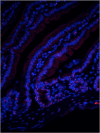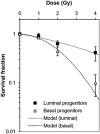Molecular and cellular basis of the dose-rate-dependent adverse effects of radiation exposure in animal models. Part I: Mammary gland and digestive tract
- PMID: 36773323
- PMCID: PMC10036108
- DOI: 10.1093/jrr/rrad002
Molecular and cellular basis of the dose-rate-dependent adverse effects of radiation exposure in animal models. Part I: Mammary gland and digestive tract
Erratum in
-
Correction to: Molecular and cellular basis of the dose-rate-dependent adverse effects of radiation exposure in animal models. Part I: Mammary gland and digestive tract.J Radiat Res. 2023 May 25;64(3):633. doi: 10.1093/jrr/rrad038. J Radiat Res. 2023. PMID: 37105533 Free PMC article. No abstract available.
Abstract
While epidemiological data are available for the dose and dose-rate effectiveness factor (DDREF) for human populations, animal models have contributed significantly to providing quantitative data with mechanistic insights. The aim of the current review is to compile both the in vitro experiments with reference to the dose-rate effects of DNA damage and repair, and the animal studies, specific to rodents, with reference to the dose-rate effects of cancer development. In particular, the review focuses especially on the results pertaining to underlying biological mechanisms and discusses their possible involvement in the process of radiation-induced carcinogenesis. Because the concept of adverse outcome pathway (AOP) together with the key events has been considered as a clue to estimate radiation risks at low doses and low dose-rates, the review scrutinized the dose-rate dependency of the key events related to carcinogenesis, which enables us to unify the underlying critical mechanisms to establish a connection between animal experimental studies with human epidemiological studies.
Keywords: animal; cancer; cell; epidemiology; low dose; low dose rate; radiation.
© The Author(s) 2023. Published by Oxford University Press on behalf of The Japanese Radiation Research Society and Japanese Society for Radiation Oncology.
Conflict of interest statement
The authors confirm they have no conflicts of interest.
Figures





Similar articles
-
Molecular and cellular basis of the dose-rate-dependent adverse effects of radiation exposure in animal models. Part II: Hematopoietic system, lung and liver.J Radiat Res. 2023 Mar 23;64(2):228-249. doi: 10.1093/jrr/rrad003. J Radiat Res. 2023. PMID: 36773331 Free PMC article. Review.
-
ICRP Publication 131: Stem Cell Biology with Respect to Carcinogenesis Aspects of Radiological Protection.Ann ICRP. 2015 Dec;44(3-4):7-357. doi: 10.1177/0146645315595585. Ann ICRP. 2015. PMID: 26637346 Review.
-
THE DOSE AND DOSE-RATE EFFECTIVENESS FACTOR (DDREF).Health Phys. 2019 Jan;116(1):96-99. doi: 10.1097/HP.0000000000000958. Health Phys. 2019. PMID: 30489371 Free PMC article. No abstract available.
-
Scaling Human Cancer Risks from Low LET to High LET when Dose-Effect Relationships are Complex.Radiat Res. 2017 Apr;187(4):476-482. doi: 10.1667/RR009CC.1. Epub 2017 Feb 20. Radiat Res. 2017. PMID: 28218889
-
The role of dose rate in radiation cancer risk: evaluating the effect of dose rate at the molecular, cellular and tissue levels using key events in critical pathways following exposure to low LET radiation.Int J Radiat Biol. 2016 Aug;92(8):405-26. doi: 10.1080/09553002.2016.1186301. Epub 2016 Jun 7. Int J Radiat Biol. 2016. PMID: 27266588 Free PMC article. Review.
Cited by
-
Low-Dose Non-Targeted Effects and Mitochondrial Control.Int J Mol Sci. 2023 Jul 14;24(14):11460. doi: 10.3390/ijms241411460. Int J Mol Sci. 2023. PMID: 37511215 Free PMC article. Review.
-
Establishment and activity of the planning and acting network for low dose radiation research in Japan (PLANET): 2016-2023.J Radiat Res. 2024 Sep 24;65(5):561-574. doi: 10.1093/jrr/rrae049. J Radiat Res. 2024. PMID: 39007844 Free PMC article.
-
Luminal progenitor and mature cells are more susceptible than basal cells to radiation-induced DNA double-strand breaks in rat mammary tissue.J Radiat Res. 2024 Sep 24;65(5):640-650. doi: 10.1093/jrr/rrae067. J Radiat Res. 2024. PMID: 39238338 Free PMC article.
References
-
- UNSCEAR . Levels and effects of radiation exposure due to the nuclear accident after the 2011 great east-Japan earthquake and tsunami. UNSCEAR 2013 Report. Volume I, Scientific Annex a. New York: United Nations, 2013, 2014, 1–311.
-
- ICRP 2007 . The 2007 recommendations of ICRP. ICRP publication 103. Ann ICRP 2007;37:1–332. - PubMed
Publication types
MeSH terms
LinkOut - more resources
Full Text Sources

